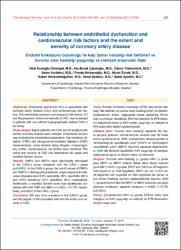| dc.contributor.author | Kurtoğlu Gümüşel, Hilal | |
| dc.contributor.author | Çatakoğlu, Alp Burak | |
| dc.contributor.author | Yıldırımtürk, Özlem | |
| dc.contributor.author | Yurdakul, Selen | |
| dc.contributor.author | Helvacıoğlu, Funda | |
| dc.contributor.author | Ziyrek, Murat | |
| dc.contributor.author | Aytekin, Saide | |
| dc.date.accessioned | 2015-01-16T12:00:33Z | |
| dc.date.available | 2015-01-16T12:00:33Z | |
| dc.date.issued | 2014 | |
| dc.identifier.citation | Kurtoglu Gumusel H, Catakoglu AB, Yildirimturk O, Yurdakul S, Helvacioglu F, Ziyrek M, Hanavdelogullari R, Aytekin V, Aytekin S. Relationship between endothelial dysfunction and cardiovascular risk factors and the extent and severity of coronary artery disease. Turk Kardiyoloji Dernegi Arsivi. 2014; 42(5): 435-43. doi: 10.5543/tkda.2014.72798. | en_US |
| dc.identifier.issn | 1016-5169 | |
| dc.identifier.uri | http://arsiv.tkd.org.tr/~/media/files/archive/documents/2014/temmuz/tkda_2014_42_5_435-443.pdf | en_US |
| dc.identifier.uri | https://hdl.handle.net/11446/662 | en_US |
| dc.description | İstanbul Bilim Üniversitesi, Tıp Fakültesi. | en_US |
| dc.description.abstract | OBJECTIVES:
Endothelial dysfunction (ED) is associated with coronary artery disease (CAD) and cardiovascular risk factors. The relationshipbetween cardiovascular risk factors, ED and the presence, extent and severity of CAD, was evaluated in patients with and without angiographically defined CAD in our study.
STUDY DESIGN:
Eighty patients with CAD and 20 subjects with normal coronary arteries were included. Endothelial function was evaluated byendothelium-dependent, flow-mediated dilatation (FMD) and nitroglycerine-mediated dilatation (NMD) measurements, using brachial artery Doppler ultrasonography (USG). Cardiovascular risk factors were identified. The extent and severity of CAD was determined via vessel and modified Gensini scores.
RESULTS:
FMD% and NMD% were significantly decreased in the CAD(+) group compared with the CAD(-) group (p=0.0001). In the CAD(+) group, the cut-off values of FMD% and NMD% in distinguishing between single-vessel and multi-vessel diseases were 8.5% (sensitivity: 95%, specificity: 62%) and 13.6% (sensitivity: 91%, specificity: 62%), respectively. Additionally, a modified Gensini score was significantly correlated with both FMD and NMD (r=-0.825, r=-0.778, respectively; p=0.0001) in the CAD(+) group.
CONCLUSION:
ED was more prevalent in the CAD(+) group, and the degree of ED correlated well with the extent and severity of CAD. | en_US |
| dc.language.iso | eng | en_US |
| dc.publisher | Turk Kardiyoloji Derneginin yayin organi | en_US |
| dc.rights | info:eu-repo/semantics/openAccess | en_US |
| dc.title | Relationship between endothelial dysfunction and cardiovascular risk factors and the extent and severity of coronary artery disease. | en_US |
| dc.title.alternative | Endotel fonksiyonu bozukluğu ile kalp damar hastalığı risk faktörleri ve koroner arter hastalığı yaygınlığı ve ciddiyeti arasındaki ilişki | en_US |
| dc.type | article | en_US |
| dc.relation.journal | Turk Kardiyoloji Dernegi arsivi | en_US |
| dc.department | DBÜ, Tıp Fakültesi | en_US |
| dc.identifier.issue | 5 | |
| dc.identifier.volume | 42 | |
| dc.identifier.startpage | 435 | |
| dc.identifier.endpage | 443 | |
| dc.contributor.authorID | TR143670 | en_US |
| dc.contributor.authorID | TR123116 | en_US |
| dc.contributor.authorID | TR140959 | en_US |
| dc.contributor.authorID | TR140960 | en_US |
| dc.contributor.authorID | TR140946 | en_US |
| dc.contributor.authorID | TR140950 | en_US |
| dc.relation.publicationcategory | Belirsiz | en_US |


















